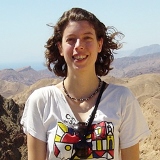
The idea that the outermost layer of the Earth is made out of discrete tectonic plates that move with respect to each other is well known, but it is still unclear how wide the plate boundaries are that accommodate this relative motion. Do the boundaries consist only of the great faults upon which major earthquakes occur? Or is the relative motion between neighboring plates distributed over wider strips of the Earth’s Crust? And how can we tell, how can we identify such strips if they exist?
In a new study published in the September issue of the journal Geology, Dr. Liran Goren (pictured) of BGU and her colleagues Sébastien Castelltort of Geneva University (UNIGE) and Yann Klinger of Institut de Physique du Globe in Paris show how the evolution of the pattern of rivers that drain mountain ranges can ‘record’ deformations associated with the relative motion between tectonic plates over the course of geological ages of millions of years, and how, if we learn to ‘read’ it, the current river pattern can tell us the pace and nature of the motion between tectonic plates along plate boundaries.
Linear mountain ranges from different parts of the world show that rivers tend to flow for the most part perpendicular to the mountain range, in the direction of the maximal gradient. But what if the mountain range undergoes significant deformation? One theory claims that river drainage systems rearrange themselves through river capture events such that the flow direction will continue to be perpendicular to the range, while an opposing theory claims that the river valley embedded in the Earth’s crust will deform along with the crust and thus record the deformation.
In their study, Goren and her colleagues focused on the northern part of the Dead Sea fault system, the boundary between the Sinai and Arabia tectonic plates. In Israel, the major portion of the movement is horizontal, where the eastern side, Jordan, moves north in relation to the western side, Israel. In Lebanon, the border changes and becomes oblique, that is, in addition to the horizontal movement between Arabia and Sinai the plates move closer to one another forming a linear mountain range: Mount Lebanon.
The Yammouneh fault is the major structure of the Dead Sea fault system in Lebanon, and it runs parallel to the Mount Lebanon range. This is an active fault, which can cause earthquakes, and is considered the boundary between the Sinai and Arabia plates in Lebanon. In their study, the researchers identified a group of rivers that drain Mt. Lebanon to the Mediterranean Sea which look as if they have been rotated. A geomorphological analysis and computer modeling have taught the researchers how to ‘read’ this specific river pattern. Following their analysis, Goren and colleagues, postulate that this sort of river geometry can be a result of horizontal deformations and shearing that are spread out along a strip 30 kilometers wide west of the Yammouneh fault. Thus, the relative motion between Sinai-Arabia along their plate boundary in Lebanon is partitioned between a large fault that can accommodate earthquakes and a wide strip of distributed shear. Practically speaking, this understanding could affect the evaluation of the seismic hazard in Lebanon. Computer modeling also shows that these rivers act as a reliable ‘recorder’ since they experience few capture events that rarely affect the direction of their flow.
